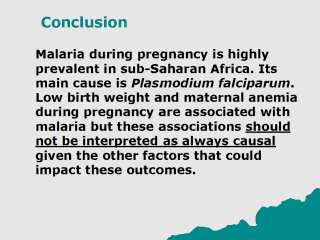Search inside of Supercourse and lectures in HTML and PPT format
 |
 |
front |1 |2 |3 |4 |5 |6 |7 |8 |9 |10 |11 |12 |13 |14 |15 |16 |17 |18 |19 |20 |21 |22 |23 |24 |25 |review |
 Malaria still remains an important public health problem in the region and negatively impacts children’s and pregnant women’s health. A multifaceted approach directed both towards prevention and treatment of the disease and other socio-economic and political factors (education, poverty, health infrastructures, political commitment and collaboration between scientists and policy-makers etc.) would be more efficient in the control of the disease and its adverse effects on maternal and child health. Therefore, there is a need to explore new other control strategies to prevent malaria in these high risk groups. Research is needed to find the most efficacious, cost-effectiveness preventive regimen and delivery mechanisms to prevent infection during pregnancy. Research is also needed to better understand the dominant underlying mechanisms of malarial anemia, and how these mechanisms are different in mild/moderate and severe anemia and their relationships with low birth weight. |